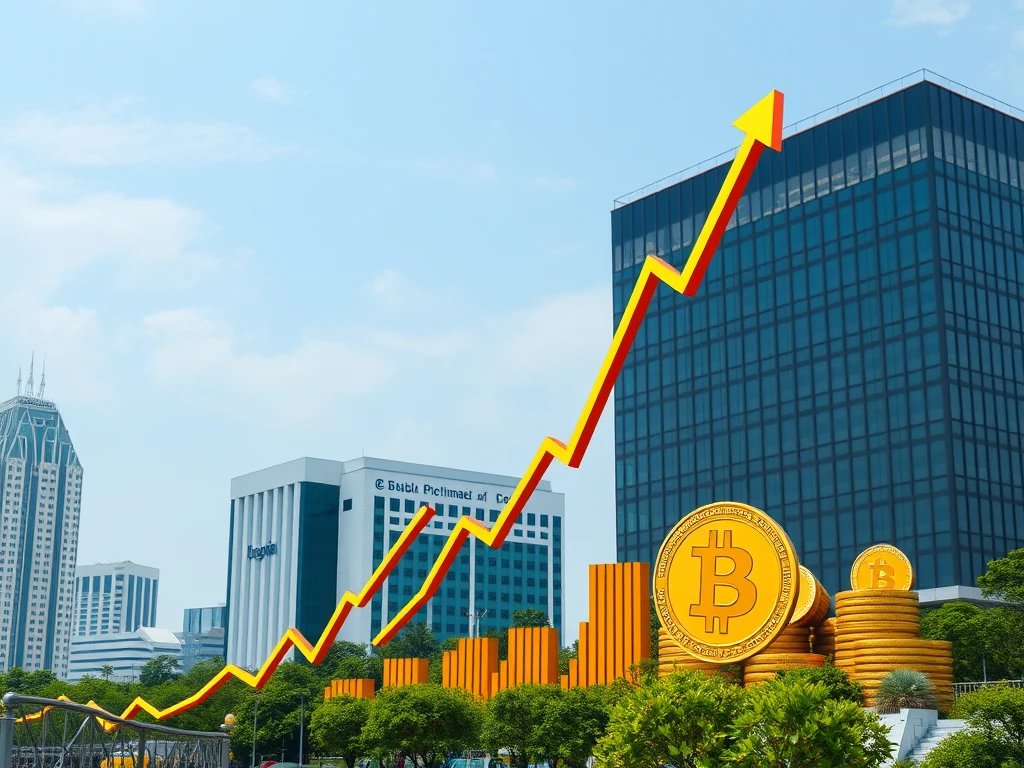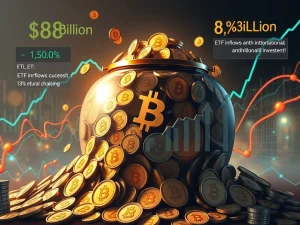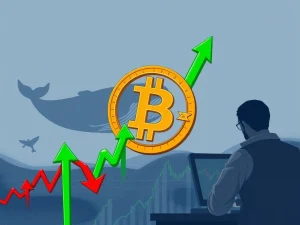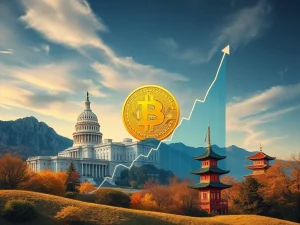Explosive Bitcoin Surge: 33% Post-Halving Rise as Institutions Disrupt Market Cycle

Bitcoin enthusiasts are in high spirits, marking a year since the 2024 Bitcoin halving with celebrations of BTC’s impressive resilience. This comes amidst a backdrop of global economic uncertainties, particularly escalating trade tensions. The narrative is shifting, with many suggesting an accelerated market cycle is underway, fueled by the increasing influence of institutional players.
Why is Bitcoin’s Price Exploding After the Halving?
The 2024 Bitcoin Halving event, a pre-programmed mechanism to control Bitcoin’s supply, reduced block rewards from 6.25 BTC to 3.125 BTC. This effectively halved the rate at which new Bitcoins are created, increasing its scarcity. Despite growing anxieties over a potential global trade war and tariff disputes between major economies like the United States and China, Bitcoin has defied expectations, climbing over 33% since April 2024, according to Crypto News Insights Markets Pro data.
Enmanuel Cardozo, a market analyst at Brickken, an asset tokenization platform, points out the mixed sentiments among investors. “So, even though Bitcoin’s showing resilience, I think the mix of past experiences, economic uncertainty, and this selling pressure is keeping investors on the sidelines, waiting for a stronger green light before they jump in,” Cardozo stated. However, he emphasizes the disruptive role of institutional investment from giants like MicroStrategy and Tether, suggesting they could be compressing Bitcoin’s traditional four-year halving cycle.
“For the 2024 halving in May, that puts the bottom around Q3 this year and a peak mid-2026, but I think we might see things move it a bit sooner because the market’s more mature now with more liquidity,” he elaborated.
Monetary policy remains a critical factor in Bitcoin’s journey. Cardozo believes a potential US Federal Reserve rate cut in May or June could act as a catalyst. “A Fed rate cut may pump more money into the system and push Bitcoin up faster,” he predicted. The halving itself is designed to ensure Bitcoin’s scarcity, a fundamental aspect of its value proposition.
Are Bitcoin ETFs the Game Changer?
The emergence of Bitcoin ETFs and broader institutional adoption are increasingly viewed as factors accelerating the market cycle. Vugar Usi Zade, COO of Bitget exchange, highlights this shift. Continuous buying pressure from institutions, especially through Bitcoin ETFs, combined with the halving-induced scarcity, could propel Bitcoin to unprecedented heights, he argues.
“With growing scarcity triggered by the halving, Bitcoin will likely retest its all-time high if it breaches the $90,000 mark in the coming weeks,” Usi Zade forecasted. He also cautioned that while the halving creates a strong foundation for growth based on supply and demand dynamics, the precise timing of its price impact can vary.
Usi Zade also noted Bitcoin’s ongoing correlation with traditional financial markets and overall investor confidence. His perspective underscores the intertwined nature of crypto and traditional finance in the current landscape.
A Faster Bitcoin Market Cycle: Fact or Fiction?
Data from crypto trader Jelle reveals a potentially accelerated market cycle. Bitcoin reached a new all-time high above $109,000 on January 20th, a mere 273 days after the 2024 Bitcoin halving. This is a significant contrast to previous cycles.
- 2017 Halving: 518 days to reach an all-time high.
- 2021 Halving: 546 days to reach an all-time high.
- 2024 Halving: 273 days (and counting, potentially faster) to reach an all-time high.
This data, shared in an April 8th X post, suggests a compression of the typical Bitcoin cycle, possibly driven by the factors discussed earlier – institutional involvement and Bitcoin ETFs.
Navigating the Evolving Bitcoin Landscape
The price increase of Bitcoin post-halving is undeniable, and the narrative of a disrupted, faster market cycle is gaining traction. However, it’s crucial to remember that the cryptocurrency market remains dynamic and influenced by numerous factors, including global economic conditions, regulatory developments, and technological advancements.
While the halving provides a fundamental supply-side catalyst and institutional interest adds demand-side pressure, external factors like monetary policy decisions and geopolitical events can significantly impact Bitcoin’s trajectory. Investors should remain vigilant, conduct thorough research, and understand the inherent volatility of the crypto market.
Key Takeaways:
- Bitcoin has surged 33% since the 2024 halving, showcasing resilience amidst global economic uncertainties.
- Institutional investment and Bitcoin ETFs are increasingly seen as factors accelerating the traditional four-year Bitcoin market cycle.
- Analysts suggest the peak of this cycle could arrive sooner than historically expected, potentially in mid-2026 or even earlier.
- Monetary policy, particularly potential US Federal Reserve rate cuts, remains a crucial factor influencing Bitcoin’s price action.
- While historical data points to a faster cycle, the cryptocurrency market is inherently volatile, and investors should exercise caution and conduct due diligence.
The 2024 Bitcoin halving is proving to be a pivotal event, potentially marking a new era of accelerated market cycles driven by institutional adoption. As Bitcoin continues to navigate this evolving landscape, the world watches closely to see if this disrupted cycle will indeed redefine the future of crypto markets.









